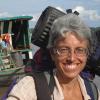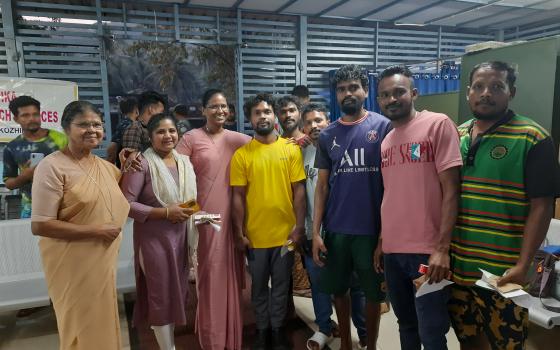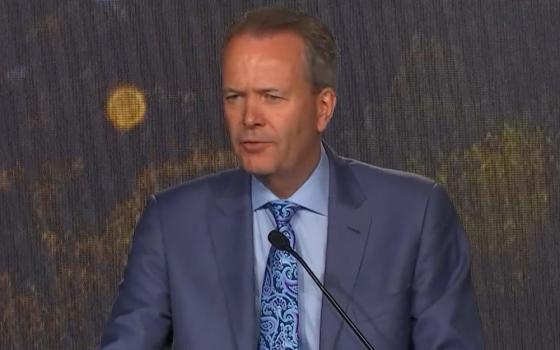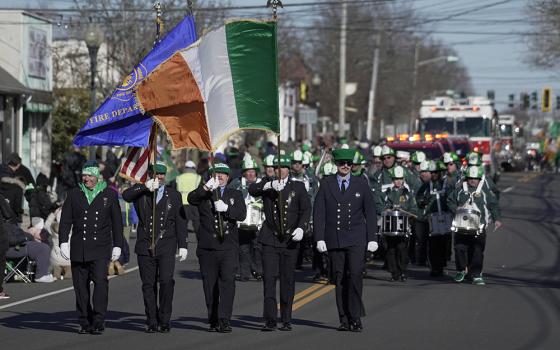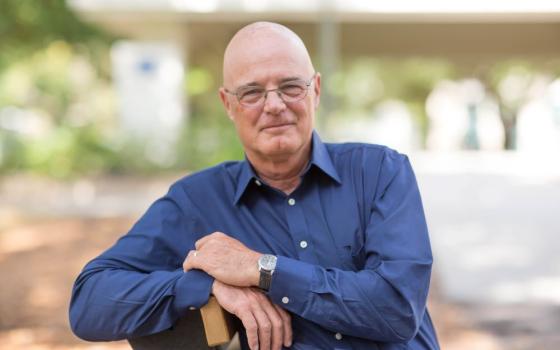
Urarina children play in the water on a hot afternoon in the community of Santa Lucía in Peru. (Photos by Barbara Fraser)
Long ago, say the Kukama elders, when animals were people, there was no water, and a woman was very thirsty. A woodpecker took pity on her and drilled into a giant lupuna tree. Sap flowed from the tree and became the river, while the lupuna's leaves became fish. Since then, the Marañón River and its tributaries have been the source and symbol of life for the Kukama, as rivers are for indigenous people throughout the Amazon. The river provides water for drinking, cooking, washing and bathing; harbors the fish on which the people depend for sustenance; and shelters the spirits by which their shamans heal.
But the Marañón River in northeastern Peru has turned from lifeblood to cesspool, picking up sewage, garbage, mine waste, and oil as it snakes down from the Andes to join the Ucayali River and form the mighty Amazon.
Already bordered by drilling platforms and a leaky oil pipeline, the river is also in the eye of developers who are targeting it for dams and dredging.
"Everyone has grand plans for the river," said Fr. Miguel Angel Cadenas, "but no one is asking, 'What is a river?' "
He was sitting with Fr. Manolo Berjón on the bow of the Santa Rita, an aging houseboat that serves as the floating home for the team from the parish of the same name. Based in the town of Santa Rita de Castilla, the parish covers a vast area that is home to about 20,000 people, most of them indigenous Kukama and Urarina. It takes three or four days to travel from one end of the parish to the other by boat -- the only means of transportation in a region that has just one 70-mile-long paved road.
As the Santa Rita chugged up the river just after dawn in early June a year ago, the villages along the bank had already come to life. Children bailed water out of dugout canoes or splashed in the shallows. Women squatted on log rafts, washing clothes or pots, or balanced buckets of water on their heads as they climbed the bank. Men returned in boats from a night of fishing, hauling their catch to open-sided wooden houses thatched with palm and raised on stilts.
As those scenes slid by, Cadenas and Berjón had their minds on the world below the surface of the muddy water, a world populated by dolphins that lured young women, the boa that gave birth to the first Kukama, and the spirits of people who drowned and whose bodies were never recovered.
That world, they said, was threatened by pollution and grand development schemes. The most recent was a plan to dredge parts of three rivers to create a waterway navigable year-round from Brazil to Peruvian cities that are connected by road to the Pacific Coast. The plan is part of a multicountry South American infrastructure integration plan, in which the river is seen as nothing more than a liquid highway, the priests said.
Under Peruvian law, indigenous communities must be consulted about any development plans that would affect their communal rights, but plans for the waterway were going ahead without the villagers' knowledge. At Berjón's suggestion, a human rights organization in Lima had taken the case to Peru's Constitutional Court. A ruling was pending.
The lawsuit was unlikely to stop the project, or perhaps even slow it much, but it was a matter of justice, Berjón said. The shallow places in the river that were targeted for dredging were the best places for fishing. Changing the river's flow could accelerate riverbank erosion in villages.
And more large vessels would pose a greater hazard to villagers' fishing boats and dugout canoes. The parish team knows that danger well. The Santa Rita's wake once swamped a canoe and a child drowned. Since then, the pilot throttles down when passing small boats on the Marañón, and the priests and sisters use smaller boats on tributaries like the Urituyacu River, in one of the parish's most distant corners.
Unknown territory
Water the shade of black coffee swirling into the cappuccino-colored Marañón signaled the Santa Rita's arrival at the mouth of the Urituyacu River, where members of the parish team were making their annual pastoral visit. For the next eight days, Cadenas and Berjón, Augustinians from Spain, would visit eight communities, while Srs. Elizabeth Quiroz and Nancy Roca, Peruvian members of the Missionary Sisters of the Sacred Heart of Jesus, visited others.
The annual flood season had ended and the water level in the rivers was going down. Unlike the broad, snaking Marañón, the black-water Urituyacu is narrow and bordered by dense forest. Annual flooding causes hardship by swamping fields of crops, but brings bounty in the form of schools of spawning fish and a layer of nutrient-rich sediment. The high-water mark showed as a dark line on the vegetation.
"The river is leaving its face on the trees," said Melita Cangoa, who had been attending a course for village leaders at the parish and was returning home.
Cadenas pulled out a red notebook ruled in squares like graph paper, the kind every Peruvian schoolchild uses in class, and wrote as Cangoa talked about the river. Despite having filled 15 notebooks, the two priests still had more questions than answers about the villages they were going to visit.
"This is unknown territory for us," Cadenas said after Cangoa disembarked in her community. The comment seemed odd, considering that he had made the trip at least once a year for the past dozen years. But a one-day visit once or twice a year is only superficial, he said. The Urituyacu alone should be a parish, with priests or sisters to support the lay Christian community coordinators in each village.
The Amazon region is a borderland, the place about which Pope Francis wrote, "The church must step outside herself. To go where? To the outskirts of existence, whatever they may be, but she must step out."
The region is full of huge parishes with not enough church workers to minister among indigenous communities that are struggling to come to terms with a barrage of changes, from soft drinks to oil spills to the Internet.
Each indigenous group has its own history and culture, and to minister effectively, the priests said, it is important to understand them. Despite years of study, they had barely scratched the surface. Just by turning off the Marañón onto the Urituyacu, they had entered another world. Most of the indigenous people in the lower Marañón River valley are Kukama; on the Urituyacu, most are Urarina.
In a region where indigenous communities are generally marginalized, the Urarina are even further from the mainstream. That was why the priests and sisters came year after year, even though an annual visit was not enough to begin to understand what ministry meant in this culture.
Ritual of certificates
The visits followed a predictable pattern. Disembarking at a village late in the afternoon, the priests were met by the Christian community coordinator and a cluster of curious children. Accommodations varied -- sometimes they unrolled their mattresses on desks in a small school, sometimes on the floor of an empty house, always rigging up mosquito nets to keep insects at bay.
A bath in the river -- the only running water -- was followed by supper with the animator's family. An evening prayer service sometimes drew only a handful of people and sometimes a larger crowd that sang enthusiastically by the light of candles or the priests' two solar-charged lamps.
The highlight of the next morning was a liturgy of the Word -- to avoid drawing a sharp distinction between their role and that of the lay leaders, Cadenas and Berjón did not celebrate Mass -- with baptisms and weddings. They unpacked their kit of candles, vestments, songbooks and a white altar cloth as parents, godparents and children gathered for the ritual.
By midafternoon, the priests would say their goodbyes, board the boat and head for the next community.
"It will be the same in every community," Cadenas said after the first stop. But he was wrong. In every village, people sought them out for help with an endless variety of problems that might be difficult to solve in a city, and that looked almost insurmountable in a place so remote.
There was the woman whose son was recruited into the Army, even though he was a minor. She had heard he was in Cusco, in the southern Andes, a world away.
There was the mother whose daughter had gone to live with her husband's family in a community on the Marañón. News had reached her that her daughter was being abused.
Many of the complaints centered on public services, which were scarce or nonexistent. In Guineal, the priests slept on desks in a school where no classes had been held, even though it was June and the school year began in March. The teacher had arrived in March, enrolled the children, then left to take the list to the district education office downriver.
He never returned. Computers from the One Laptop per Child program gathered dust in boxes damp from the high humidity. Food provided by the government's school nutrition program was spoiling. Community leaders had lodged a formal complaint, an expensive process involving a six-day round trip to Nauta, not counting the time spent trying to get face-to-face with an official in the district education office.
Nothing was done. That happened every year, said Simon Inuma Manizari, Guineal's apu, or president. None of the village's teenagers had finished school. "They've grown up and they don't know how to read," he said.
Guineal and the other communities on the Urituyacu are far from the world of smartphones and supermarkets. People hunt or fish and farm small plots of bananas and cassava, a starchy, tuberous root, occasionally selling some to merchants who ply the river on wooden boats. If food is scarce, they go hungry.
In remote places like this, births and illness and deaths are more often attended by traditional healers and relatives than by medical professionals, and people may die without ever having received documents identifying them as citizens. That gives baptismal certificates added importance, and filling out the certificates is a ritual in itself, taking an hour or more before each morning liturgy.
Pentecost found the priests in Triunfo, one of the few communities that had a chapel -- this one with a steeple, overlooking the community's soccer pitch. As people filed in for the service, a couple handed Cadenas the identity documents of their two children. The surname was spelled differently on each.
"This is a serious problem. If something happens someday, a lawyer could say these children aren't siblings," Cadenas said. "You love your children, and you want the government to treat them well."
Misspellings are not uncommon, and parents often do not correct the error. Like the school district office and the health center, the registrar's office is far away, and the trip is costly and time-consuming.
"There's a serious problem of discrimination against people who live on the river," Cadenas told the villagers. "When we are baptized, we are all equal. It's not a matter of pouring water over the child. It's fulfilling what the Bible says -- that there are no longer differences. But here, there are."
As he and Berjón prepared to begin the liturgy, a woman with a deeply lined face spoke up. She wanted to be baptized, so Cadenas began to fill out one more certificate. But she did not have an identity document, did not remember her father's full name, and did not know her age.
The assembled villagers pitched in to estimate her age and choose the year -- 1944 -- while her daughter picked a date in December. Along with the children, she was baptized with water from the river, blessed and poured from a bowl made from the shell of a gourd-like fruit.
Changes in the valley
Heading homeward, the priests made one last stop in a tiny community that was home to a single extended family. They had met the father, Juan Macusi, during a workshop when he began to sing in a language the Urarina participants did not understand. The man was Omurana, an ethnic group that does not even appear on Peru's official list of indigenous peoples. They might have been the original inhabitants of the watershed, eventually displaced by the Urarina, who themselves were pushed upriver be a wave of Kukama migrants more than half a century ago.
Before the baptism, Macusi got out the long blowgun that had been his hunting weapon until traders stopped bringing the poison he used to tip the darts. Setting an orange on a post, Macusi tested his visitors' skill. Cadenas and Berjón each puffed into the long tube, but the dart went wide.
Just as the blowgun gave way to the shotgun, other changes are sweeping the valley. Lumbering passenger and cargo ferries now compete with outboard vessels that cover the same distance in a fraction of the time. Soft drinks and soda crackers are replacing masato, a traditional, labor-intensive drink made of fermented cassava.
The market economy is edging out the barter system that knit communities together. More and more people have moved to cities, temporarily or for good.
The priests followed them. They were transferred in February from the Marañón to Iquitos, where decaying, tile-faced houses bear witness to the bygone elegance of the rubber-boom days.
But they did not leave the river behind. In March, they sat in a courtroom as government officials appealed a lower court ruling calling for the waterway-dredging project to be suspended until indigenous communities were consulted.
The appeals court upheld the ruling. Although the consultation is unlikely to stop the project, Berjón called it a turning point -- the first time an indigenous organization had won recognition of its right to consult on a major infrastructure project.
Meanwhile, he and Cadenas set out on daily walks around their new parish, La Inmaculada. With its paved streets and motorized rickshaw traffic, it bears little resemblance to the indigenous villages along the Marañón and Urituyacu rivers, but it has roots there. Although part of the parish is middle-class, it also includes the large, chaotic port where riverboats dock. Precarious houses near the port are home to people who have migrated to the city in search of jobs and are navigating the transition from rural to urban life. Learning to minister there will take time.
"You have to make an effort to understand the situation in which the people live," Cadenas said. "The challenges are great."
[Barbara Fraser is freelance journalist based in Lima, Peru.]
